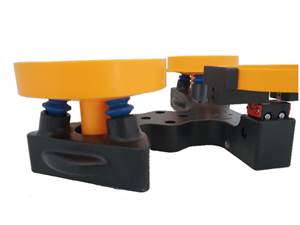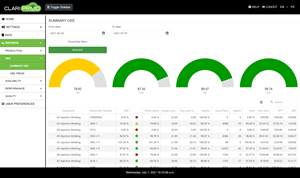Modular Conveyor Boosts Productivity and Profits for Toothbrush Manufacturer
Close Up: Conveyors
Automation in plastics processing can involve sophisticated, high-tech manufacturing cells specialized for a particular application (see NPE feature this month ). Or it can involve much simpler, off-the-shelf solutions that offer the user flexibility to configure—and reconfigure—an automation system according to the job and plant layout.
Automation in plastics processing can involve sophisticated, high-tech manufacturing cells specialized for a particular application (see NPE feature this month ). Or it can involve much simpler, off-the-shelf solutions that offer the user flexibility to configure—and reconfigure—an automation system according to the job and plant layout. Modular conveyors are an example of the latter.
A case in point is Radius, a manufacturer of premium toothbrushes in Kutztown, Pa. (radiustoothbrush.com). The firm injection molds the toothbrush handles from cellulose acetate propionate at around 400 F melt temperature. The handles drop into a cooling tank of water at around 50 F before they are dried and sent on to the station where bristles are added. The problem was that the chilled water cools the outside of the handles while the interior remains hot. With a two-cavity mold, there was a risk of handles falling on top of one another while the inner core was still soft, leaving dimples that rendered the products unusable. To combat this, Radius used an air bubbler that pushed the handles around after they fell into the tank.
That solution, however, was less than perfect. “We had about a 23% reject rate, and this is a multimillion-dollar product for us,” said Radius co-founder Kevin Foley. “Then, of course, you have to regrind that plastic and remake the product to keep up with orders.”
KEEP THEM MOVING
Radius decided to address the problem with a new tank outfitted with a modular belt conveyor from Dynamic Conveyor Corp. (DynaCon), Muskegon, Mich. (dynamicconveyor.com). Foley immediately recognized the flexibility provided by DynaCon’s modular, reconfigurable design. “We broke our unit completely apart when we got it,” said Foley, so his team could try out several different configurations, experimenting with conveyor length and speed. “When we had to expand the lineal distance, we were able to add length to the conveyor and put it back together very easily.”
With the toothbrush handles falling onto a moving conveyor in the cooling tank, the scrap rate dropped to 10%. Then Radius had a brainstorm that enabled it to cut rejects much further. Vertical fins were placed on the belt, creating compartments that maintained separation between the handles as they fell into the cooling bath. Radius also discovered that it could use the bubbler to push air through the grid surface of the plastic conveyor belt. “By the time the handles settle down, they’re sitting on the belt, not on another toothbrush,” explained Foley. This dropped our reject rate to about 1.5%.”
Radius discovered additional benefits on the discharge side of the water bath. Previously, a bristling machine operator sometimes had to stop production and use an air gun to dry out the bristle holes. Now, two box fans above the conveyor dry the parts completely before they drop into bins for bristling. Foley said this addition allowed Radius to increase the belt speed. DynaCon also developed a timing mechanism for filling bins automatically, which Foley anticipates will allow Radius to mold handles overnight on a “lights out” basis.
“The complaint I always heard from assembly is that we never have enough parts. Now we have plenty of inventory,” said Foley, who calculated the annual dollar savings with the new conveyor at $27,000. “Beyond that, we have the ability to make product 16 hours a day instead of eight.”
Related Content
BMW Group Vehicle to Adopt 3D Printed Center Console
A vehicle coming to market in 2027 will include a center console carrier manufactured through polymer robot-based large-format additive manufacturing (LFAM).
Read MoreEnsuring Repeatability: The Key to Effective Injection Molding Automation
One of automation’s key promises is repeatability: the same movement to the same location, time and time again. But to achieve that, all elements involved — robot, machine, EOAT, mold — must be in and stay in alignment.
Read MoreReal-Time Production Monitoring as Automation
As an injection molder, Windmill Plastics sought an economical production monitoring system that could help it keep tabs on its shop floor. It’s now selling the “very focused” digital supervisor it created, automating many formerly manual tasks.
Read MoreICIS Launches: Ask ICIS Generative AI Commodities Assistant
Said to be the first of its kind, this AI assistant will enhance access to ICIS’ intelligence and insights for the energy and chemical markets.
Read MoreRead Next
Making the Circular Economy a Reality
Driven by brand owner demands and new worldwide legislation, the entire supply chain is working toward the shift to circularity, with some evidence the circular economy has already begun.
Read MoreSee Recyclers Close the Loop on Trade Show Production Scrap at NPE2024
A collaboration between show organizer PLASTICS, recycler CPR and size reduction experts WEIMA and Conair recovered and recycled all production scrap at NPE2024.
Read MoreBeyond Prototypes: 8 Ways the Plastics Industry Is Using 3D Printing
Plastics processors are finding applications for 3D printing around the plant and across the supply chain. Here are 8 examples to look for at NPE2024.
Read More













